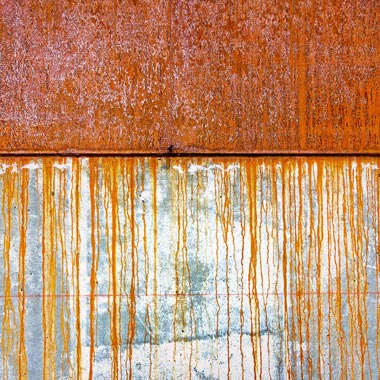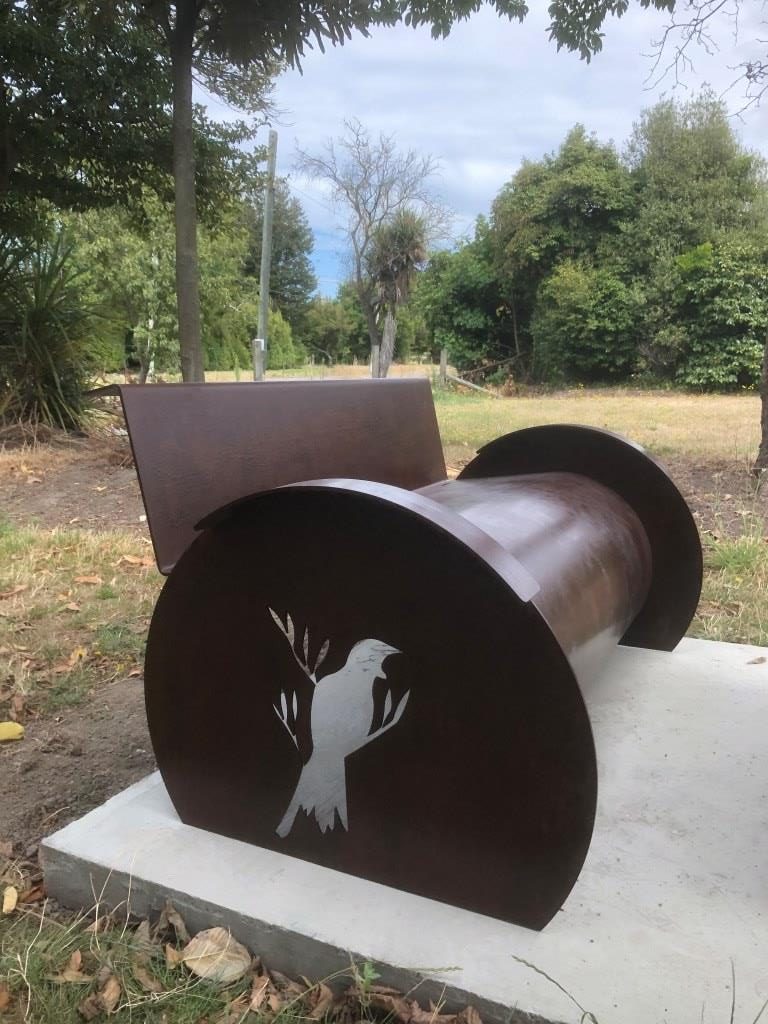Rusted Metals
Seal Rusted Metals and protect with an Everbrite Coating
You can seal rusted metals to prevent rust stains ruining the look of your building or hard landscaping, pavers.
Seal rusted metals including weathered steel and Corten.
Rusted metals is a rising trend in architecture and art as Architects all over the world are embracing rust-weathered steel to enhance the patina.
Unfortunately, rusted metal can cause stains that drip onto areas under the metal. Everbrite Protective Coating seals rusted metals to prevent further rusting and prevents the rust dripping and staining problems.
You may like the way that rusted metal looks on your sculpture or architectural feature - but you will soon hate the way that the rust stain drips.


Benefits from Sealing Rusted metals
Everbrite™ and ProtectaClear® Coatings provide the following benefits when you seal and protect rusted metals
- Eliminates staining of surrounding areas from unsightly runoff and stains. Rusty drips on other substrates can ruin the look of a building.
- Eliminates transfer of rust to people (hands & clothing).
- Helps to extend the life of the steel by sealing out moisture that can cause further corrosion.
- Gives the surface a more finished, purposeful look.
- Excellent adhesion on naturally or artificially rusted surfaces.
- Everbrite™ and ProtectaClear® are self annealing and will blend to itself as further coats are applied to create complete protection.
- Everbrite™ and ProtectaClear® are available in a clear Natural Gloss finish or a Satin finish.
- Everbrite™ and ProtectaClear® will seal moisture out of rusted metal to help prevent further corrosion and will prevent rust stains.
Rusted Metal Projects
GARDEN ART

BUILDINGS, UTILITIES

PUKEAHU WAR MEMORIAL PARK – WELLINGTON

JOHN TAYLOR MEMORIAL SEAT – CHCH

Which Coating for rusted metals ? Everbrite or Protectaclear
Everbrite™ coating is suitable for all rusted metal and rusted mild steel projects. It is thick with anti-oxidants and works well with porous metals like naturally rusted metal, corten or other steels. All of our coatings are heat resistant up to 260 – 285 degrees centigrade. The coatings will gas off at about 350 degrees centigrade.
Which finish? Natural Gloss or Satin
The clear formula of Everbrite™ natural gloss can be glossy on rusted or on dark colored metals. Once it is coated, the metal will look like it does when it is wet. The Satin formula is generally used for a far reduced shine. Satin finish has a sheen but not a high shine. If Natural Gloss has been used but a lower sheen finish is desired Satin can be used for the final coat(s).
How much coating do I need to seal rusted metals?
Mild Rusted Steels and Rusted Corten are more porous than smooth metals; and can take up to 50% more coating for the first coat. The thicker the rust, the more coating it will take to seal it.
Generally it will take 4 generous coats to seal exterior rusted metals; and 3 generous coats for indoor locations; as long as the substrate is sanded to a smooth finish with all loose rust having been knocked off. If the rust is thick then more coats will be required to encapsulate the rusted surface.
As a minimum:
For exterior multiply the surface area to be coated by 4.5
For interior multiply the surface area to be coated by 3.5
e.g. 2 square metres surface area in an outside location will require coating to cover 9 square metres. (4.5 x 2 sq m.)
Shop Now
Shop for an Everbrite Protective Coating to seal rusted metals & corten
How to Seal Rusted Metal and Prevent Staining
- Rusted metal is porous so care must be taken to ensure that the metal is completely clean and dry. Blooming rust (raised thick and heavy rust) should be knocked down to a smooth surface and Acetone solvent used to help remove contaminants like grease or oils. The solvent will also help draw out moisture because coating and sealing moisture in the pores of metal can cause failure of any coating.
- The metal MUST be completely dry and smooth before applying the coating.
- If an acid based compound has been used to assist with the rusting process then the metal will need to be neutralised and thoroughly rinsed off with clean water and then dried well (bone dry) before solvent wiping and applying the first coat.
- As raw steel or rusted metals are so porous 3 to 4+ coats are recommended with the first coat requiring extra coating than normal.
- Everbrite™ will seal the metal and it will look great for years and can be maintained indefinitely.
Link to full Instruction Sheet – pdf
How to Rust Metal on purpose and do this quickly
Some people recommend rusting metal with dangerous chemicals like muratic acid, sulphuric acid or combinations of chemicals. This is not only dangerous to your health but can damage other items as well.
One inexpensive way to rust metal on purpose is to spray vinegar and hydrogen peroxide separately on the metal. (any kind will do – the cheaper the better). First, make sure the metal is clean, remove all millscale and any oil or dirt. You can sandblast the metal or use Scotchbrite pads to clean the surface. Spray the vinegar on the clean metal. Using a separate sprayer, apply hydrogen peroxide over the vinegar right away. Do this several times a day and your metal will get rusty. Make sure to neutralize the acid from the surface and rinse well. Then, let the metal dry completely, solvent wipe and apply Everbrite™.
Or you can use our Rust Enhancer. Just paint on and within a few hours have the perfect rusted fnish.
Ongoing Cleaning & Maintenance
AFTER CARE
Do NOT use solvent or citrus based cleaners or abrasives to clean coated metal.
Do NOT use cleaners with petroleum distillates.
Suggested cleaner: Mild soap and water.
MAINTENANCE
Once coated the coated surface is easy to maintain.
Perform a rust transference test after the last coat has dried, and again after the coating has fully cured. Thereafter periodically thereafter to check if/when a maintenance recoat is needed. This testing is important.
Test to see if enough coating is applied by wiping with a clean cloth after the coating is completely dry. If rust comes off on the cloth, additional Everbrite™ coat(s) should be applied as follows:
Wipe surface with a damp cloth to remove dirt and residue, dry well, and recoat. Longevity between recoats is dependent on adequate application (coating thickness and number of coats) the environment, and general use and abuse.

FAQ
Some people recommend rusting metal with dangerous chemicals like muratic acid, sulphuric acid or combinations of chemicals. This is not only dangerous to your health but can damage other items as well. One inexpensive way to rust metal on purpose is to spray vinegar and hydrogen peroxide separately on the metal. (any kind will do – the cheaper the better). First, make sure the metal is clean, remove all millscale and any oil or dirt. You can sandblast the metal or use Scotchbrite pads to clean the surface. Spray the vinegar on the clean metal. Using a separate sprayer, apply hydrogen peroxide over the vinegar right away. Do this several times a day and your metal will get rusty. Make sure to neutralize the acid from the surface and rinse well. Then, let the metal dry completely, solvent wipe and apply Everbrite™.
Or you can use our Instant Rust Accelerator. Have the perfect rusted fnish within a few hours. Details here.
Everbrite is easy to apply. Clean the surface and apply Everbrite™. It is best NOT to use any water while cleaning. Use solvent like denatured alcohol (meths or acetone) to clean the surface. This will also help to draw out any moisture in the porous metal. The rusted metal MUST be completely clean and DRY. Everbrite can be painted on with a brush, sprayed on or rolled on with a microfibre roller. Three to four plus (4+) coats are recommended on rusted metal because the metal is very porous and will absorb the coating. The first coat must be applied with a brush or roller to ensure that the coating is worked well into the pores of the metal. Subsequent coats can be sprayed.
Rusted metal is very porous. The amount of Everbrite necessary to encapsulate the rust will depend on the depth of the rust. Using a Prep Pad or other slightly abrasive pad can remove raised rust or thick rust and this will help to smooth out the metal but will still look rusted. Enough coatings must be applied on the rusted metal to encapsulate the rust. Normally, 3 to 4 thick coats of Everbrite are applied but if the rust is heavy and thick, it will take additional coats. Test to see if enough coating is applied by wiping with a clean cloth after the coating is completely dry. If rust comes off on the cloth, additional Everbrite™ should be applied.
If you are unsure, we would recommend purchasing a small container of both the Natural Gloss finish and the Satin finish of Everbrite™. Clean the metal and apply 2 coats of the clear formulation first. Let it dry and see if you like the finish. If so, add another coat(s) of the clear gloss finish. If it is too shiny, you can then apply a Satin/Matte finish over the top of the Everbrite™ that has already been applied.
Trouble shooting
What will happen if you do not adhere to the instructions?
Failure to adhere to the instructions will probably result in having to remove the coating and start again.
PHOTO: Top half shows what happens when instructions are not adhered to.

Bottom half shows the surface after removing with wire brush ready for recoating.
- Common causes when the coating lifts and/or where there is water ingress and an ‘oil slick’ appearance occurs
- Too much rust bloom – the raised rust and ‘pimples’needed to be knocked back to a smooth surface.
- The metal is not completely dry – Climatic conditions can affect how dry the metal is. Recent rain, humidity and cold weather can all cause the metal to retain moisture. When the fixtures are outside it is strongly recommended that the surface it dried with a heat gun prior to the solvent wipe. Ensure the metal cools down afterwards before the solvent wipe.
- Failed to solvent wipe – A solvent wipe is required with meths, xylene or acetone (nothing else) immediately before the first coat is applied. This helps with the adherence of the coating and draws out any hidden moisture sitting in the pores in the metal.
- Not enough coats were applied – At least 3 to 4 thick coats are required for rusted metal items when located outside in all weather conditions. Failure to completely seal the rust will allow water ingress. Some rusted metal surfaces can take more than the srandard 3 or 4 coat coverage.
- Each of the coats were not thickly enough applied – The first coat should be brushed or rolled on to ensure that the coating adheres well into the pores of the metal. Ensure that subsequent coats are rolled on lightly with a thick coating, without pulling off the previous coat. to a
How to rectify a failed application
You need to remove the coating that has trapped moisture under it, which has not adhered properly.
There are three ways you can remove the coating:
- Remove the coating with Xylene solvent; or
- Clean off the coating with a wire brush; or
- Sand off or Sandblast off
Just before reapplication of the first coat ensure to solvent wipe with xylene, meths or acetone.
Apply adequate number of coats and do a rust transference test to determine if further coats are required.
Undertake a rust transference test periodically to see when a maintenance coat is required.
